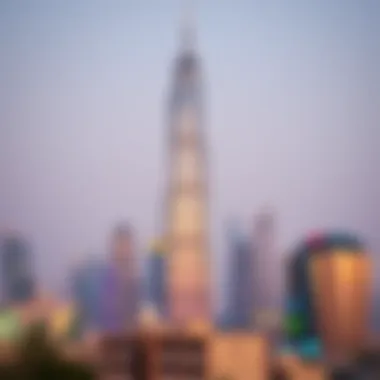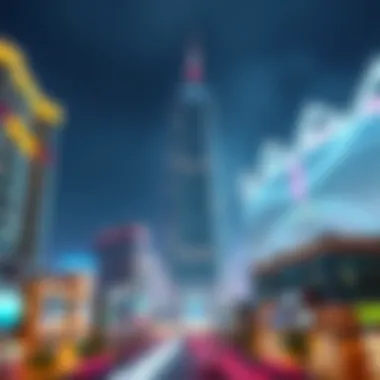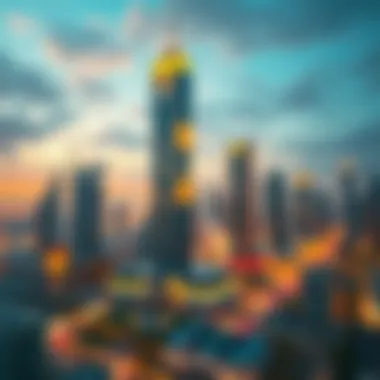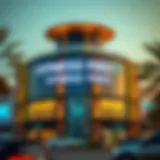Exploring the World Trade Center Dubai: History and Impact


Intro
The World Trade Center in Dubai is not just a collection of soaring towers; it stands as a testament to the city’s ambition and entrepreneurial spirit. Built against the backdrop of rapid economic growth, this complex symbolizes Dubai's transition from a modest coastal town into a global trade hub. Understanding its importance requires delving into the layers of history, architecture, and the interplay of social and economic factors that brought this iconic landmark to life.
Neighborhood Features
Landscaping Highlights
Surrounding the World Trade Center, one can find carefully curated landscapes that enhance the overall aesthetic appeal. The area boasts lush greenery complemented by artful water features, creating a blend of natural and urban elegance. Palm trees sway gently, providing shade as the sun beats down, while the orderly layout of plant beds adds a touch of sophistication. Pathways meander through the landscape, inviting visitors to explore not just the architectural marvel but also the serene surroundings.
Architectural Styles
The architectural design of the World Trade Center is a fascinating fusion of modernity and traditional Arabian influences. The clean lines of the buildings contrast beautifully with intricate Islamic patterns embedded in facades. The glass and steel structures reflect the sky, providing a canvas that changes with the day's light. Notably, the most recognizable feature, the UAE's flag-shaped spire of the main tower, reaches high into the skyline, symbolizing the nation’s aspirations.
Community Life
Local Events and Activities
The World Trade Center serves as a hub for numerous events, fostering community engagement and interaction. From international trade exhibitions to cultural festivals, the venue invites a variety of gatherings throughout the year. Notably, the Dubai International Convention and Exhibition Centre often hosts major events, showcasing local and international businesses while providing a platform for networking and collaboration.
Lifestyle Amenities
Life around the World Trade Center offers diverse amenities catering to residents and visitors alike. Numerous cafes and restaurants line the streets, providing everything from quick bites to gourmet dining. Shopping options abound, with a blend of luxury boutiques and local shops, ensuring that both tourists and local citizens find what they need. Moreover, recreational spaces are thoughtfully integrated, ensuring that leisure activities are easily accessible, making the area not just a business district, but a vibrant community.
"The World Trade Center Dubai is a key piece in the puzzle of the city's identity; it reflects the past and points toward the future."
For further insights into the World Trade Center and its surrounding environment, you may visit Wikipedia or check comprehensive articles on platforms like Britannica and discussions on forums like Reddit.
In exploring the different facets of the World Trade Center Dubai, readers will gain a well-rounded understanding of its significance, not just in Dubai but in the broader context of global trade and culture.
Foreword to the World Trade Center Dubai
The World Trade Center in Dubai serves as a vital lynchpin within the city's rapidly evolving landscape. This landmark is not simply a building but a symbol of Dubai's aspirations, ambitions, and its significant role on the global stage. Understanding the World Trade Center is crucial for several reasons. Firstly, it embodies Dubai's meteoric rise from a humble trading post to a thriving metropolis. Secondly, its architectural brilliance reflects the innovative spirit of the city, setting benchmarks for future developments in the region. Lastly, the center acts as a nexus for commerce, culture, and community activities, representing a microcosm of what modern Dubai has to offer.
Historically, the World Trade Center has functioned as a sophisticated venue for international trade and business exchange, attracting corporations and investors from around the globe. Its strategic location and comprehensive facilities make it a beacon for economic opportunity. The sheer scale of activities hosted here helps illustrate the dynamics of Dubai as a commercial hub and highlights the significance of the city’s role in world trade.
Historical Overview
The origins of the World Trade Center in Dubai can be traced back to the early 1970s when the need for a central business district became apparent. The building was conceptualized during a time when Dubai was ambitiously stepping into the global arena. Completed in 1979, the World Trade Center was one of the first skyscrapers in the region, with a height of 149 meters. Its unique architecture set the stage for future high-rises, blending traditional Islamic elements with modern design features. Over the years, it has stood witness to significant historical milestones, from Dubai's first international trade fairs to key governmental meetings that shaped economic policies.
"The World Trade Center doesn't just hold offices; it holds the legacy of Dubai's ambitions and dreams."
The historical importance of the center goes beyond its architectural features. It is intertwined with events that charted the course of Dubai's growth and integration into the global economy. It has attracted international businesses, empowered local entrepreneurs, and played a pivotal role in establishing the city’s reputation as a significant player in world trading activities.
Purpose and Vision
The core purpose of the World Trade Center is to serve as a multifunctional space that fosters trade and commerce. It was envisioned as a hub where global businesses could establish connections, gain insights into market trends, and forge partnerships. Beyond its commercial pursuits, the center aims to promote Dubai as a global city, enhancing its visibility and appeal in the international arena.
The vision behind this impressive structure was to create a space that would encourage innovation and collaboration within various sectors. This is evident in its diverse amenities—ranging from exhibition halls to conference rooms—designed to accommodate a plethora of activities, such as conferences, trade exhibitions, and cultural events. This versatility reflects a forward-thinking approach, illustrating how spaces can be optimized to meet changing needs and foster economic growth.
In a nutshell, the World Trade Center is more than bricks and mortar; it's a living organism that adapts to the evolving demands of business, culture, and community. With its ongoing developments, the center continuously seeks to enhance its offerings, reinforcing Dubai's status as a pivotal node in global trade.
Architectural Significance
The architectural significance of the World Trade Center in Dubai cannot be overstated. It serves multiple roles, from its function as a commercial hub to its visual and cultural representations within the city. The building showcases not only modern design but also encapsulates the ambitious spirit of Dubai. The aesthetic appeal and structural integrity are critical considerations in its allure, and they give a sense of place and identity to a bustling metropolis.
Design Influences
The design of the World Trade Center in Dubai borrows from various architectural styles, reflecting the city's diverse cultural fabric. Elements of Islamic architecture are seamlessly integrated, using contemporary materials that keep it relevant in today's skyline. The interplay of steel and glass is striking, effectively utilizing natural light while maintaining the necessary functionality of office space.


- Local Context: The structure respects and complements local traditions while pushing the envelope in architectural innovation. Reference points can be found in traditional wind towers, which offer natural ventilation, much like the World Trade Center's modern adaptations.
- Global Trends: Influenced by global architectural trends, the design also pulls from the Mies van der Rohe and Frank Lloyd Wright philosophies, emphasizing simplicity and the relationship between the building and its environment. These diverse influences coexist harmoniously, showcasing a building that is not only functional but is also a work of art.
Structural Composition
When examining the structural composition of the World Trade Center, a few key components stand out. The building's use of a robust steel framework allows for its towering height, while innovative foundation work adapted to the sandy ground of Dubai underscores engineering prowess. Additionally, the integration of modern materials ensures longevity and durability.
- Foundation Elements: The foundation itself is anchored deep into the ground, which is vital considering the region’s geological nuances. This is a typical strategy in construction here, dealing with potential subsurface complications.
- Vertical and Horizontal Dynamics: The balance between vertical spaces (elevators, stairwells) and horizontal designs (floors, roofs) offers both beauty and efficiency. This attention to detail enables the rapid transit of people and goods throughout the building.
Technological Innovations
The World Trade Center exemplifies a myriad of technological innovations that elevate its operational efficiency. Incorporating cutting-edge technology not only benefits the users but also serves to reduce overall environmental impact.
- Energy Management Systems: Advanced energy management systems have been implemented, tweaking resource usage and focusing on sustainability. The incorporation of solar panels and energy-efficient cooling systems represents a commitment to reducing the carbon footprint, an ever-important consideration in urban planning today.
- Smart Building Features: Integrated smart technology, including automated lighting and HVAC systems, offer individual control for occupants, enhancing comfort while promoting responsible energy consumption.
"The World Trade Center stands not merely as a structure but as a testament to the possibilities of modern architecture and urban engineering."
The architectural significance of the World Trade Center extends beyond the mere bricks and mortar. It symbolizes Dubai’s ambition, weaving together history, culture, and innovation into the very fabric of the city. The building serves as an anchor point that draws locals and visitors alike, solidifying its place in both the economic and cultural landscape of Dubai.
Economic Impact on Dubai
The World Trade Center Dubai serves as a cornerstone in the economic landscape of the Emirate, acting as a catalyst for growth and development. Its significance transcends beyond the mere architectural marvel it presents; it is a vibrant hub that contributes to Dubai’s status as a leading global trading center. In this section, we will explore the dynamics of commercial activities within the center, how it attracts global investments, and the employment opportunities it creates. Understanding these elements is crucial for grasping the overarching importance of the World Trade Center in shaping Dubai’s economy.
Commercial Hub Dynamics
At the heart of Dubai’s bustling economy lies the World Trade Center, a bustling commercial hub infused with energy and potential. It hosts various businesses, ranging from startups to multinational corporations. The very structure acts as a magnet for diverse industries, creating a melting pot of ideas and innovations. Many firms use this facility not just for office space but as a strategic launchpad for regional and global operations.
- Networking Opportunities: One major aspect contributing to its role is the plethora of networking events and exhibitions organized here. These events provide a platform where businesses can interact, strike deals, and form partnerships that would otherwise be impossible.
- Market Accessibility: Situated in a prime location, the World Trade Center is easily accessible. This accessibility attracts businesses that want a foothold in the Middle East, thus cementing Dubai's role as a trade intermediary between Asia, Europe, and Africa.
"Economic vibrancy is generated when businesses thrive in a collaborative environment, and that's exactly what the World Trade Center offers."
Attracting Global Investments
One of the standout features of the World Trade Center is its ability to draw in global investments. Investors are often on the lookout for locations with high growth potential and favorable business climates, and Dubai ticks those boxes neatly. The facility hosts international trade fairs, bringing together buyers and sellers from all corners of the globe.
- Incentives for Foreign Investment: Dubai offers numerous incentives to foreign investors, including tax breaks and 100% ownership rules in designated free zones. The World Trade Center benefits from these incentives, enhancing its appeal.
- Global Partnerships: By facilitating partnerships between local and international entities, the center opens doors for foreign capital. This not only boosts the local economy but also enhances Dubai’s connection to global markets.
Employment Opportunities
With the influx of businesses and investments, the World Trade Center inevitably becomes a significant source of employment opportunities for Dubai’s residents. The variety of industries represented means that people from different backgrounds and skill sets can find suitable roles. Employment ranges from clerical jobs to high-level managerial positions, accommodating a wide demographic.
- Diverse Job Market: The jobs generated are diversified, catering to various skill levels. This diversity is a boon for the local workforce, as it means individuals can find roles that match their qualifications and experience.
- Skill Development: Many companies also focus on employee training programs, fostering skill enhancement among the workforce. This focus on development not only benefits the businesses involved but also creates a more skilled labor pool for Dubai.
In summary, the World Trade Center Dubai embodies the economic vitality of the city. Its role as a commercial hub, a facilitator of foreign investments, and a generator of employment opportunities are crucial elements that shape and sustain Dubai’s dynamic economy. As the landscape continues to evolve, the center will likely remain integral to the Emirate’s economic strategy.
Cultural Relevance
The World Trade Center in Dubai stands as a testament to cultural integration and evolution in a city known for its rapid transformation. Its significance extends beyond commerce; it acts as a vibrant hub where art and community converge, shaping the cultural landscape of the UAE. This center is not just bricks and mortar; it's a living tapestry reflecting the rich narratives of diverse communities that call Dubai home.
Art and Exhibitions
Art plays a pivotal role in enhancing the cultural fabric of the World Trade Center. The venue frequently hosts exhibitions featuring local and international artists, sparking conversations about creativity and innovation. These displays are not just visually appealing; they are gateways to understanding different backgrounds and artistic expressions.
For example, the annual Art Dubai fair, held nearby, draws gallery owners, collectors, and enthusiasts from around the globe. It connects artworks from the Middle East with global trends, providing a platform for emerging artists. Reflected in the halls of the World Trade Center, the interaction between art and business creates a unique dynamism, enriching the viewer's experience.
- Key Notable Features of Art at the WTC Dubai:
- Diverse talent representation: Featuring a mix of established and emerging artists.
- Cultural reflections: Artworks often express themes relevant to the socio-economic landscape of Dubai.
- Interactive exhibitions: Many installations invite viewer participation, fostering engagement and dialogue.
Community Events and Activities


Community events at the World Trade Center are the lifeblood that keeps the spirit of togetherness alive in Dubai. These events range from cultural festivals and food exhibitions to business seminars and workshops. They invite locals and tourists alike to immerse themselves in the melting pot of cultures that Dubai embodies.
Among the standout events is the Dubai Shopping Festival, which attracts thousands each year, blending commerce with cultural experiences via performances, live music, and regional cuisine. Workshops on sustainability and entrepreneurship make room for knowledge-sharing, further establishing the center as a focal point for growth and collaboration.
- Benefits of Community Engagement at WTC Dubai:
- Cultural exchange: As people from different backgrounds come together, they share traditions and customs.
- Promotion of local talent: Events often spotlight local artisans and businesses, giving them visibility.
- Social cohesion: Regular activities strengthen community bonds, fostering unity and collaboration.
The World Trade Center Dubai serves as a melting pot of culture, drawing individuals from various walks of life to participate in its vibrant community events and exhibitions.
In essence, cultural relevance at the World Trade Center goes beyond being a mere aspect of the complex. It is interwoven into the core identity of Dubai, reinforcing the principles of diversity and inclusion within an ever-evolving society. This cultural dynamism not only reflects the characteristics of the city but also propels it into the future, making it a place of continual growth and inspiration.
Surrounding Landscape and Urban Planning
The World Trade Center in Dubai is not just an isolated structure but is intricately interwoven with its surrounding landscape and urban planning. This integration is crucial for a multitude of reasons, fostering a harmonious relationships between built environments and the natural world. Understanding the nuances of this relationship allows for a deeper appreciation of the center's role in Dubai's overall urban fabric.
Integration with Surrounding Architecture
The architectural narrative of the World Trade Center extends beyond its own walls. It converses with surrounding structures, forming a cohesive skyline. Each building contributes its own story, yet they all work towards a grander vision of modernity. For instance, the design of neighboring towers often reflects or complements the unique features of the World Trade Center. This attention to architectural dialogue enables the complex to maintain a unique character amidst Dubai's rapid development.
Importantly, the integration does not merely serve aesthetic purposes. Well-planned urban spaces facilitate pedestrian flow, which is significantly essential in a bustling trade hub. Think about it: when visitors step out of the World Trade Center, they are likely to be greeted by an inviting streetscape that beckons them to explore nearby shops, cafes, or public spaces.
Green Spaces and Public Areas
Incorporating green spaces into urban planning around the World Trade Center is paramount, shifting the focus from concrete jungles to vibrant places for relaxation and social engagement. The green areas surrounding this iconic landmark offer a much-needed breath of fresh air amid the urban hustle. These spaces serve as important community gathering points, often hosting events, farmers’ markets, or art fairs.
Benefits of these green spaces include:
- Improving air quality: Trees and plants contribute to cleaner air, making the area more pleasant to be in.
- Promoting biodiversity: By allowing for the growth of various plant species, the ecosystem thrives.
- Enhancing mental well-being: Access to parks and greenery has been linked to reduced stress and improved quality of life.
Public areas are designed not only for aesthetics but also for functionality. They provide venues for cultural events, performances, and art installations, reinforcing the narrative of the World Trade Center as a cultural as well as a commercial epicenter. As one walks through these spaces, they may notice how seamlessly they blend nature with urban life's vibrancy.
"Green spaces have the uncanny ability to reconnect urban dwellers with nature, offering a soothing counterbalance to the fast-paced, commercial environment."
In a nutshell, the surrounding landscape and urban planning of the World Trade Center in Dubai demonstrate a careful consideration of community needs, sustainability, and architectural coherence. This deliberation ensures that the structure continues to play a pivotal role in shaping not just the skyline, but the very essence of Dubai's urban experience.
Future Developments and Expansion Plans
The foresight of the World Trade Center Dubai extends deeply into its future. As the region continues to grow and adapt to global changes, planning for expansion and enhanced functionality becomes pivotal. The ambitious vision behind these developments seeks not only to maintain the center's status as a premier business hub but also to enrich its role in the community and contribute to sustainable urbanization.
Proposed Projects
In the pipeline, various projects aim to complement and enhance the existing structures of the World Trade Center Dubai. Notable among these is the idea of expanding the exhibition and conference spaces, ensuring that the center remains a sought-after venue for international business forums, trade shows, and cultural events. This could potentially include:
- Multi-purpose Convention Halls: Envisioned as flexible spaces, these halls will cater to different types of gatherings, from corporate retreats to large-scale conventions.
- Integrated Mixed-Use Developments: Plans include incorporating residential and commercial units that would interact with the existing trade center. This can provide convenience for professionals working in the area, fostering a vibrant work-life dynamic.
- Enhanced Transport Links: Projects might also focus on improving accessibility to the center through additional public transit options, easing congestion and encouraging a steady flow of visitors.
These developments are expected to not only boost foot traffic but attract a diverse range of businesses, further solidifying Dubai's reputation as a global trading nexus.
Sustainability Initiatives
With an eye on environmental impact, the future plans for the World Trade Center also emphasize sustainability as a core principle. The importance of sustainable practices cannot be overstated in today’s rapidly evolving architectural landscape. Initiatives set to be implemented may include:
- Green Building Certifications: Aim for LEED (Leadership in Energy and Environmental Design) certification alongside other eco-friendly attributes, showcasing a commitment to energy efficiency and reduced carbon footprints.
- Smart Technologies: Incorporating building automation systems that optimize energy use, manage lighting effectively, and maintain comfortable indoor climates will be critical components of any new development.
- Water Conservation Measures: Efforts will include rainwater harvesting systems, water-efficient landscaping, and wastewater recycling practices to minimize water consumption within the premises.
These sustainability initiatives not only address environmental concerns but also appeal to a growing base of businesses and investors prioritizing green practices in their operations.
Comparative Analysis with Other Global Trade Centers
In a world where globalization reigns supreme, trade centers serve as the backbone of economic exchange and cultural interaction. To fully appreciate the significance of the World Trade Center Dubai, it's crucial to compare it with other global trade centers. Such comparisons reveal the center's unique attributes, operational strategies, and the lessons it can offer. Furthermore, understanding these differences can shed light on Dubai's ongoing ambition to solidify its status as a global economic powerhouse.


Key Differentiators
When examining the World Trade Center Dubai against its international peers like the World Trade Center New York or the Tokyo International Forum, several key differentiators emerge:
- Strategic Location: Unlike many trade centers nestled in major urban areas, the World Trade Center Dubai benefits from its location within the Middle East, which serves as a strategic junction connecting Europe, Asia, and Africa. This positioning attracts numerous multinational companies looking to leverage cross-continental trade routes.
- Architectural Styles: The architectural approach is distinctive. While the World Trade Center in New York is known for its historical significance and iconic skyline shape, Dubai's structure boasts modern designs that resonate with its rapid economic growth and futuristic vision, encapsulating the essence of innovation.
- Diverse Functions: The Dubai Trade Center not only serves as a hub for commerce but also actively engages in cultural and social activities. This multifaceted approach contrasts sharply with some of its more traditional counterparts, which primarily focus on business and trade alone.
- Integration of Technology: The incorporation of cutting-edge technology for both operations and visitor engagement sets Dubai’s center apart. Interactive exhibits, real-time data displays, and smart systems enhance the experience, making it appealing to a range of stakeholders, from visitors to commercial tenants.
- Economic Framework: The economic strategies applied within the World Trade Center Dubai capitalize on various industries including tourism, real estate, and technology, which is broader than what many other trade centers engage in. This holistic approach fosters resilience against economic downturns, providing greater stability.
Lessons Learned
A comparative analysis not only reveals differences but also provides valuable insights that other trade centers can learn from. Here are some key takeaways:
- Flexibility is Key: The ability of the World Trade Center Dubai to adapt to the dynamic economic landscape offers a significant lesson. Trade centers worldwide should prioritize flexibility in operations to remain relevant amidst changing global conditions.
- Collaboration Across Sectors: The successful integration of different sectors underscores the necessity of collaboration. The Dubai model showcases how facilitating partnerships between public, private, and cultural entities can enhance overall functionality and attract global interest.
- Sustainability Practices Matter: Emphasizing sustainability as seen in Dubai’s ongoing projects should be a priority for trade centers worldwide, as both investors and consumers increasingly prefer environmentally-conscious operations.
"Trade platforms are not just about business; they're cultural beacons that shape local communities and global connections."
In sum, the comparative analysis with other global trade centers shines light on the World Trade Center Dubai’s distinctive qualities and strategic innovations that contribute to its standing as a significant player in the global economic arena. The lessons learned extend beyond its walls, offering a pathway for other centers to evaluate their strategies and embrace a more integrated approach toward trade and community engagement.
Further reading can be found on Wikipedia and Britannica.
Challenges Facing the World Trade Center
The World Trade Center in Dubai stands tall not just in terms of its structure, but also as a beacon facing various challenges that can affect its place in the global arena. Understanding these challenges is key to comprehending how this iconic site can navigate a complex landscape. Economic fluctuations and social dynamics are two significant aspects that warrant a closer look, as they directly influence the effectiveness and relevance of this trade hub.
Economic Fluctuations
Economic conditions are like the weather—some days it’s sunny, and other days it’s pretty stormy. The World Trade Center is not immune to the global economic climate that can swing dramatically from boom to recession. When economies are thriving, trade activities swell, boosting demand for rental spaces and increased foot traffic. Conversely, during economic downturns, businesses tighten their belts, leading to lower occupancy rates and rental revenue.
In recent years, Dubai has experienced notable fluctuations in its economic landscape, largely tied to global oil prices and regional politics. For instance, when oil prices plummeted, Dubai felt the pinch, leading to decreased investments in sectors tied directly to traditional business channels. As a result, the World Trade Center, which aims to attract global businesses and investors, has had to adapt its strategies continuously.
Moreover, the rise of digital commerce offers another layer of complexity. Traditional trade centers face competition not only from each other but also from online platforms that offer businesses easier, often cheaper ways to connect with customers. They must innovate to stay relevant: by hosting tech expos, digital marketplaces, and setting up spaces that cater to e-commerce businesses.
- Diversification of offerings is essential for resilience.
- Establishing connections with emerging markets can lessen the blow from economic dips.
- Developing partnerships with tech companies could provide a buffer against declining traditional business models.
Social Dynamics
Social dynamics in Dubai present another layer of challenges that affect the World Trade Center’s role. The melting pot that is Dubai brings together a diverse workforce, leading to unique challenges in understanding and addressing the needs of various demographic groups. For example, as expatriate populations shift, so do spending habits and consumer preferences. Aligning the offerings of the World Trade Center with the evolving needs of these varied groups is crucial.
Cultural tensions can arise in a global hub like Dubai. Striking the right balance between local traditions and the international business ethos can be tricky. If not managed well, this can lead to discontent among local communities or backlash from expatriate workers who might feel sidelined. It’s about creating a common ground that respects local customs while fostering an open and inclusive environment for international business.
Lastly, social issues such as housing affordability, administrative support for new businesses and labor rights can have ripple effects on the trade environment. If the community around the World Trade Center does not thrive, the economic ecosystem weakens. Addressing social challenges could include:
- Engaging in community outreach programs to foster local relationships.
- Creating workspaces that encourage collaboration between different demographics.
- Providing resources for small business empowerment and support.
The World Trade Center, facing these economic and social challenges head-on, needs to develop a proactive approach, ensuring its sustained relevance in an ever-changing global landscape. A focused commitment to adapting to these realities can determine the effectiveness of this important trade institution in Dubai’s economic and cultural fabric.
Only by acknowledging and addressing its challenges can the World Trade Center continue to be a pillar of trade and culture in the region.
Further Resources
- Dubai Economic Report 2023
- Cultural Insights from Dubai - UAE Government
- Global Trade Dynamics - Britannica
Closure
In wrapping up our thorough exploration of the World Trade Center Dubai, it becomes crystal clear that this structure is more than just a set of buildings reaching for the sky. It functions as a pivotal thread in the rich tapestry of Dubai's identity, weaving together history, culture, economy, and future aspirations. Each section discussed in earlier parts of the article highlights unique elements that underline the importance of the World Trade Center, and its evolving role in the local and global landscape.
Summarizing Key Insights
The World Trade Center Dubai stands as a beacon for international trade and cultural exchange. Its architectural brilliance merges with multifunctional spaces that cater to a variety of economic activities, making it a vital hub for businesses far and wide. Here are a few key points that encapsulate the insights of our discussion:
- Historical Foundation: Established to symbolize Dubai's ambition on the global stage, its historical significance can't be overstated.
- Architectural Mastery: The unique design and structural innovations make it a standout example of modern architecture.
- Economic Engine: The center is a commercial powerhouse that attracts investments and offers a myriad of employment opportunities.
- Cultural Fusion: With art exhibitions and community events, it embodies the cultural heartbeat of Dubai, fostering local engagement and international collaboration.
The World Trade Center's Future Role
Looking ahead, the significance of the World Trade Center Dubai seems poised to grow even further. Amid ongoing developments, it is set to become an even more integral player in both regional and global domains. Here are factors to consider:
- Emerging Trends: As global trade infrastructures evolve, the WTC will adapt to meet these new demands. Expansion plans and sustainability initiatives are already on track to enhance its offerings.
- Cultural Integration: Future projects may also emphasize cultural exchange, enhancing connectivity between different communities, thus enriching Dubai's already vibrant community fabric.
- Technological Advancements: Array of technological innovations are anticipated to enhance operational efficiencies, making interactions smoother for everyone involved, from tenants to visitors.











